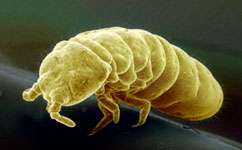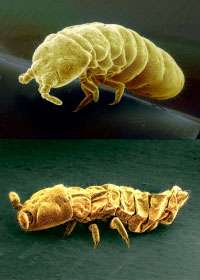Bleach and antifreeze integral to Arctic animal survival

Bleach and antifreeze are natural chemicals that help one creature survive the Arctic winter by triggering cryogenic preservation, say scientists.
Arctic Springtails start to produce hydrogen peroxide - better known as household bleach - when the temperature in Svalbard cools to a tipping point of -2oC.
This prompts them to dehydrate and become cryogenically frozen in time.
The Arctic Springtail is a small, mite-like creature that lives under rocks in the Arctic, where temperatures can get as low as -20 oC.
During winter these small creatures completely dry out, pushing all of the water out of their bodies until they could be mistaken for a 'crumpled up crisp packet,' says Dr Melody Clark from the British Antarctic Survey, co-author of the study.

Scientists knew from studies on yeast and fungi that hydrogen peroxide is likely to be an important part of the dehydration process. But its exact involvement was, until now, unclear.
Cryogenic drying out has to happen very slowly, and in a 'very controlled way so that they can actually survive winter and come 'back to life' in summer,' explains Clark. 'Chemical triggers can help control and regulate that process.'
Clark says, 'as animals cool they produce hydrogen peroxide which causes a cascade of biochemical processes.' One of these processes is needed to prevent ice from freezing their body tissues.
Springtails produce their own natural antifreeze - a sugar called trehalose- which prevents this from happening. The same theory is also used in cryonics, to preserve the bodies of people who hope to be resuscitated by future technology.
During Arctic winters more water is turned to ice, leaving less moisture in the air.
This gives springtails, which have lots of water in their bodies, the perfect opportunity to dehydrate. They make their skins porous so that water will naturally seep out into the dry air.
Springtails remain under the cliffs in this frozen, shrivelled state for the entire winter which can last several months. When spring arrives the ice melts and raises the amount of water vapour in the air - ensuring rehydration.
This research was conducted as part of a, now ended, EU project known as Sleeping Beauty, to look at the mechanisms which cause animals to completely dry out so they can cope with extreme cold.
This is just one of several papers to come out of the EU study but now the funding has finished and one of the major pioneers in the field, Dr Roger Worland, has retired - leaving the future for this research topic uncertain.
More information: Grubor-Lajsi¿ G, et al. (2013) Hydrogen peroxide and ecdysone in the cryoprotective dehydration strategy of Megaphorura arctica (Onychiuridae: Collembola) Arch Insect Biochem Physiol. 82(2):59-70. doi: 10.1002/arch.21073
Provided by PlanetEarth Online
This story is republished courtesy of Planet Earth online, a free, companion website to the award-winning magazine Planet Earth published and funded by the Natural Environment Research Council (NERC).


















